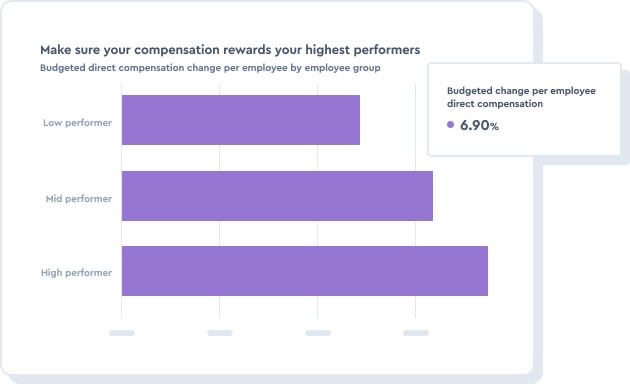7 Key Compensation Metrics for Effective HR Management
Optimize your compensation strategy by harnessing the power of tracking key compensation metrics to improve talent acquisition, transparency, and pay equity.

Compensation—the monetary and non-monetary rewards you give employees for their work—is an essential component of any business. It keeps people satisfied and motivated and can improve retention.
Creating a successful compensation strategy requires helping you acquire talent with ease, improve transparency, and maintain pay equity. One of the key steps to achieving this is tracking and analyzing compensation metrics.

What are compensation metrics?
Compensation metrics are tools and quantitative measures used to assess a company’s compensation practices. These metrics evaluate both financial and non-financial rewards, aiding organizations in assessing pay fairness and the efficacy and market competitiveness of their compensation strategies.
Why should you track compensation metrics?
You can’t offer fair compensation if you pay little attention to your compensation strategy. Tracking compensation metrics offers several benefits during this process, such as:
Ensuring pay equity. By analyzing different compensation metrics, you can identify and correct pay disparities. It’s an essential step for a diverse and inclusive workplace and will help you align with various regulations.
Supporting talent acquisition and retention. Employees prefer to work with companies that are transparent about their compensation policies and offer competitive pay rates.
Controlling costs. Offering bonuses and merit raises is a great strategy, but most companies will also need to work with a fixed budget. Analyzing compensation metrics helps you find the best solution to reward everyone fairly while keeping track of costs.
Improving decision-making. Tracking compensation metrics will help the company make data-informed decisions when it comes to its compensation strategies.
Creating pay ranges. Compensation metrics set the stage for creating pay ranges that will later ensure pay equity and transparency.
Improving employee satisfaction and engagement. When employees are paid and rewarded fairly, they’re likely to perform better and be more satisfied with their work.
7 HR metrics to measure employee compensation
Compensation metrics help you create a better compensation strategy, improving many processes in the company. Here are a few critical ones to track:
1. The salary range
The salary range (also known as the pay range) defines the minimum and maximum boundaries for a position or the entire company. An important part of the pay range is the midpoint. This is the average pay for a certain position and will usually be the job’s market rate.
Why you should track it
Tracking this metric helps you structure your compensation more effectively, makes it easier to set salaries for new hires, and offers pay transparency.
2. Compa-ratio
The comparison ratio, in short, compa-ratio, compares an employee’s salary with the midpoint of the salary range or with the market average. To calculate it, you need a simple formula:
A ratio of under 100% shows the person is receiving a salary below the midpoint or the market average. If the rate is over 100% the person’s compensation is above the midpoint.
Why you should track it
The compa-ratio gives you an understanding of how competitive your compensation plan is and is critical for maintaining fair, competitive, and strategic compensation practices.
3. Total cost of workforce (TCOW)
This metric includes all the expenses you have with staff and related expenditures. The salaries, bonuses, benefits, but also the amount you spend on training, and even work-related travel—all make up the total cost of the workforce.
Many companies are aware of how much they spend on salaries. But these other expenses tend to become a bit blurrier. These expenses can add up quickly and before you know it, you’re going over the planned budget.
Why you should track it
Tracking the total cost of the workforce is essential for budget and resource allocation. It also improves the decision-making process and can help you create better reward programs and similar initiatives.
4. Merit increases
A merit increase rewards an employee for their stellar performance. Many companies award these rewards annually, but different distribution schedules are also possible. Bonuses and other non-financial rewards may be present while a merit increase is usually equivalent to an increase in the salary.
Giving everyone a merit reward may sound like a good idea, but it would also lose its purpose. That’s because instead of rewarding people according to their performance, you’d simply be giving them an annual raise.
To tackle this, a lot of companies choose to use the forced distribution rate. This is a performance management approach where you assess your employees based on their performance relative to their peers. It helps them compensate people at different levels, based on their performance.
Why you should track it
Tracking this metric helps you keep track of the rate at which you’re adjusting your budget for merit increases, while also helping you create a better merit reward program.
5. Market ratio
The market ratio shows you how the midpoint of a salary range for a role compares to the market average for the same role.
Why you should track it
Tracking the market ratio helps you see how your payment structure compares to that of other companies. It is essential for attracting and retaining top talent or if you want to create a strategic compensation strategy.
6. Length of employment
The length of employment, or an employee’s tenure with the company, often plays a critical role in deciding their pay. Someone who’s been with the company for 10 years, for instance, could get a salary that’s closer to the high end of the pay range. Meanwhile, someone who just started will be closer to the low end.
Why you should track it
Tracking this metric helps you improve your compensation plan and rewards people for their work. It can also improve employee retention, as people will know their efforts and dedication don’t go unnoticed.
7. Wage gap
The wage gap refers to any disparities in pay between genders, ethnicities, or other demographic factors. The gap is unrelated to a person’s experience or tenure.
Having a wage gap in your company can have a serious impact on your DEI efforts. It signals that not everyone has the same opportunities and you’re not rewarding people fairly for their work.
Why you should track it
Tracking this metric will ensure you spot and address wage gaps. It improves inclusivity in the company, but it can also avoid any legal troubles.
Using people analytics to measure compensation
Compensation may not be the only component of a successful, productive, and engaged workforce, but it is a critical one. Rewarding everyone fairly for their efforts should be a top priority for a company. On top of boosting the overall employee experience, it will also help you attract top talent with ease and improve the company’s reputation.
Tracking compensation metrics offers a simple way to assess various aspects of your compensation management plan. They help you understand the salary range and how it compares to the market average. They’re also essential for addressing wage gaps based on gender or other demographics.
Creating a smart compensation plan requires a strategic approach. You need to reward everyone fairly and keep up with the market average while also staying within your budget’s limits. Visier Smart Compensation makes compensation planning effective from the first step.
Biases, conscious or unconscious, can make their way into the best business plan, but they shouldn’t impact your compensation process. Smart Compensation helps you address biases before they affect your organization, creating a transparent and fair pay system.
This supports managers so that they can make data-driven decisions, paving the way for open compensation conversations with employees.
Ready to automate your compensation workflows? By using people analytics, Smart Compensation offers a complete view of each person’s pay structure, their performance, and other relevant data. In the end, you’ll reward everyone fairly, according to factors that truly matter like performance, tenure, and experience.

Look at the budgeted direct compensation changes to ensure your compensation plan rewards your highest performers.
On the Outsmart blog, we write about workforce-related topics like what makes a good manager, how to reduce employee turnover, and reskilling employees. We also report on trending topics like ESG and EU CSRD requirements and preparing for a recession, and advise on HR best practices like how to create a strategic compensation strategy, metrics every CHRO should track, and connecting people data to business data. But if you really want to know the bread and butter of Visier, read our post about the benefits of people analytics.



